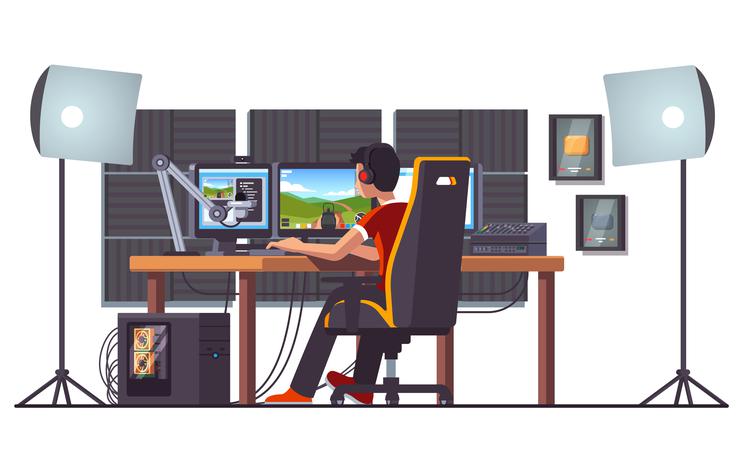Here is our list of the best content creators on YouTube, Instagram, and TikTok to…
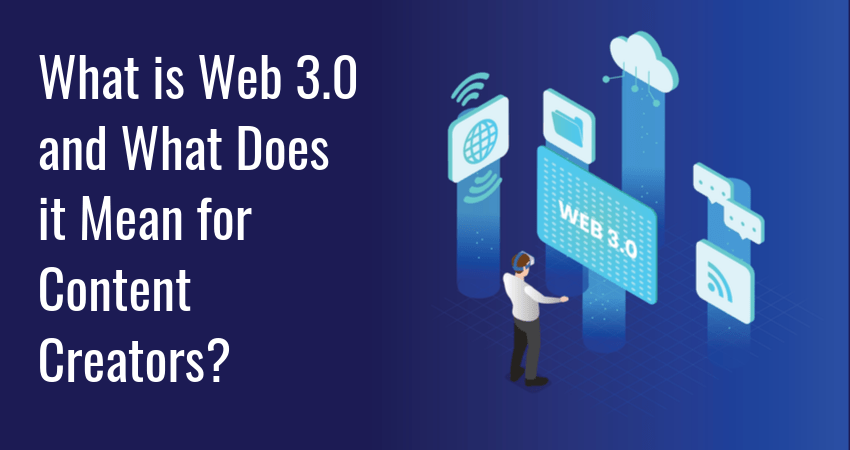
What is Web 3.0 and What Does it Mean for Content Creators?
There is a lot of buzz surrounding Web 3.0. According to its adherents, the third iteration of the World Wide Web is set to revolutionize how we use the internet. There are also skeptics who see it as nothing more than marketing hype.
While these two camps argue, content creators are trying to figure out what’s their stake in the matter. There are reasons to believe Web 3.0 will open new opportunities for content production, distribution, and content monetization. On the flip side, there are also concerns related to privacy, regulation, and even the feasibility of the technologies being proposed.
It’s tough to get a handle on these things because so much of it is still speculation, so we’ve tried to look at what is certain in order to give you an indication of how 3.0 could transform content production in the future.
Web 3.0 Definition
Web 3.0 encompasses a whole range of ideas about how the internet will work in the future. It is sometimes used interchangeably with the term ‘semantic web’, but most proponents of Web 3.0 tend to give it a broader meaning.
In this extended version, Web 3.0 refers to a vision of the internet that integrates the semantic web, blockchain and cryptocurrencies, AR and VR, the internet of things, artificial intelligence, as well as several vague notions such as decentralization, ubiquity, and connectivity.
From this, we can gather that Web 3.0 is a placeholder name for a collection of speculative ideas about the future of the internet, rather than a concrete thing.
What Does Web 3.0 Mean for Content Creators?
Web 3.0 is something content creators should pay close attention to for several reasons.
First, Web 3.0 is a gold mine for content ideas. Even though Web 3.0 is still in its earliest phase, bloggers, podcasters, video makers, streamers, and other content creators can already make content that incorporates AI, the blockchain, etc.
If you are into gaming, check out the best Rust streamers, Minecraft streamers, or Hearthstone streamers you can follow. Alternatively, have a look at our list of best content creators on YouTube, Instagram, and TikTok.
Second, Web 3.0 will bring several new technologies to the table, some of which could make content production faster, more efficient, and easier to monetize. For example, advancements in AI text generation could empower writers to produce better content, while NFTs offer new monetization options for video makers.
Finally, even if only half of the claims of Web 3.0 enthusiasts turn out to be true, the world will undergo radical changes. In a world where AR is commonplace, all transactions are on the blockchain, and high-speed internet covers the globe, the way people consume content is bound to be different. Understanding Web 3.0 today is therefore essential for adapting to the future.
Web 1.0, Web 2.0 and Web 3.0: A Short History
Web 3.0 is the third stage in the evolution of the internet. Each preceding stage has defining features, which we will go over briefly.
Web 1.0
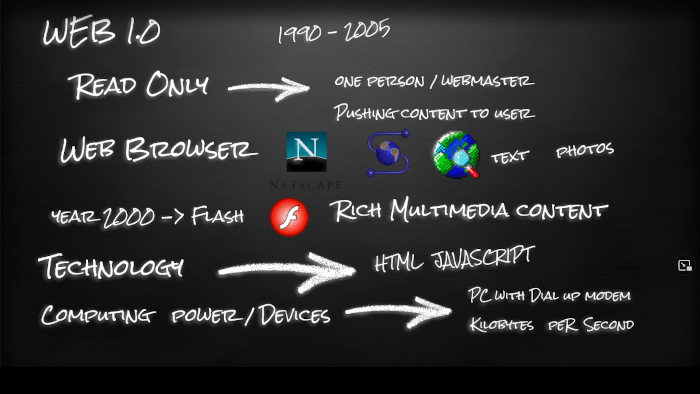
During the 90s, Tim Berners-Lee pioneered what we know today as core Web technologies: HTML, HTTP, and URL. These technologies made it possible to develop static websites and host them on servers across the globe.
At the time, websites were mainly used for hosting text documents and images. In this sense, Web 1.0 is not a thing of the past – the internet is still largely used for hosting content, and text is still the most widespread form of content.
Web 2.0
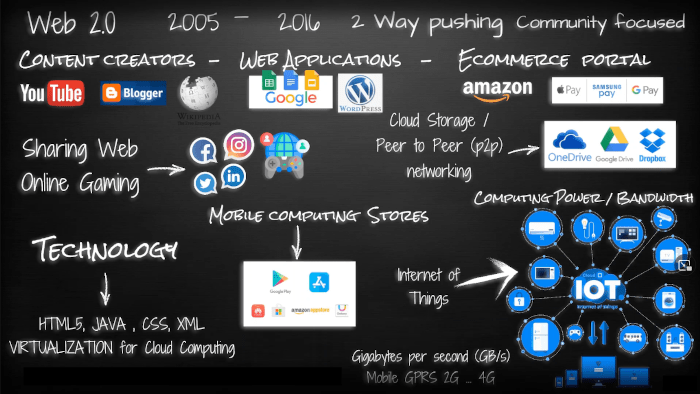
By the early 2000s, Web technologies had improved significantly, which made it possible to design websites with a broader range of functionalities. This is the period when social networks and user-generated content gained prominence, transforming popular ideas about what the internet was for.
We are still living in the era of Web 2.0, but there is disagreement whether we’re nearing its end, or there’s still a long way to go.
Web 3.0
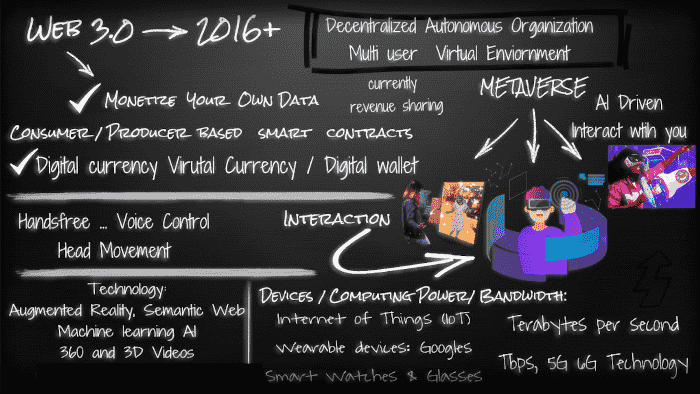
In the past several years, technologies such as the blockchain, machine learning, and 5G have accelerated the development of the Web, leading some to believe that we’re entering a new era.
Web 3.0 is still in its infancy but some predictions, such as AI-driven search algorithms, have already been implemented. As these advancements accumulate, we will see more and more people reference our era as the age of Web 3.0.
Check out our take on the current content monetization trends and read our predictions about all the future trends involving the influence of web 3.0 and NFTs.
Web 3.0 Features
Now that we have a general idea of what Web 3.0 is, let’s go into some of the concepts commonly associated with it. The extent to which these ideas are relevant for content creators varies and will change as Web 3.0 technologies become more widely available. Here are the key concepts to pay attention to.
Semantic Web
The semantic Web concerns itself with making all data on the internet machine-readable. The idea here is that while current machines are good at understanding the formal features of a language, they have trouble parsing meaning and intent.
The goal of the semantic Web initiative is to transform each piece of human-readable content into machine-readable metadata. For example, documents marked up with an extended version of the standard HTML <meta> tag could provide contextual information about the content. A meta tag could contain entries such as “animal”, “zoo”, “edible”, etc., which would allow hypothetical semantic web crawlers from the future to understand what the content is actually about.
Blockchain
The blockchain is a system for public bookkeeping of online data. The core idea here is decentralization. The blockchain doesn’t depend on a single entity or institution to guarantee whether an online transaction is valid. Instead, it uses public consensus built on top of the collective data of every participant.
The blockchain is mainly associated with cryptocurrencies, but the technology has a whole range of other potential applications, including smart contracts, NFTs (non-fungible tokens), and DAOs (member-owned communities without centralized leadership represented by formal rules and encoded as a computer program and hosted on the blockchain).
Artificial Intelligence
The definition of artificial intelligence remains elusive, but huge strides have been made in the development of one particular AI model – the neural network. These systems attempt to simulate the workings of the human brain on a vast scale, making it possible to analyze large data sets and spot difficult-to-find patterns. The range of applications for this technology is practically limitless: image recognition, speech synthesis, virtual assistants, text generation, to name a few.
Internet of Things
Faster internet infrastructure, such as 5G, is making it possible to connect more kinds of devices to the Web, including factory machines, household appliances, public infrastructure, and even consumable products. This enables the development of autonomous devices that act based on the combination of immediate sensory input, and data gathered from other networked devices on the Web.
Glimpse is here to help you prepare for the Web 3.0 revolution. Host your content on Glimpse and start monetizing your work with the sponsorship system. Share your game servers with fans and supporters. Go live and collect donations from stream viewers. Withdraw your earnings at any point, and pay zero fees.
Metaverse
The concept of the metaverse predates Facebook’s recent rebranding and attempts to cash in on the hype. The metaverse is simply any system that is attempting to simulate reality using computers. Examples of the metaverse include various MUD and MMO games, virtual worlds such as Second Life, and even VR.
NFTs
NFTs use blockchain technology with the aim of regulating the concept of digital property. Their application is currently limited to selling overpriced art and Twitter posts, but it’s rapidly expanding. NFTs in gaming is the latest trend to hit the news, with several NFT game titles rising to prominence in recent years.
Personalized Intelligent Searches
A search engine’s effectiveness depends on two things: its ability to understand user search intent, and its ability to rapidly query databases to provide relevant results. After reaching a certain threshold with these abilities, search engine algorithms will provide personalized intelligent searches. They’ll be able to understand the user’s intent behind the search and quickly find the most relevant results.
The key idea is that keywords will no longer be the basic elements of search. Instead, search engines will build up semantic and psychological profiles for each user over time, to figure out how they think, instead of what words they use.
Decentralization
Web 3.0 aims to be more decentralized than the previous iterations of the World Wide Web. Thanks to technologies such as IoT, it will become possible to process data independently and have storage units that communicate with each other without the need for a centralized system. This has the potential to shake up the existing monopolies in the software sphere the driving idea behind decentralization is that users become the owners of their data.
Connectivity
Web 3.0 encourages greater connectivity between Web nodes for more efficient data processing. This notion is closely related to two other technologies, Edge Computing and the Internet of Things. The idea is that smart devices with powerful sensors and data processing capabilities can function as autonomous units for all data processing and gathering tasks.
Instead of sending data to a server for processing, receiving feedback, and adjusting behavior, Web 3.0 devices could theoretically do all calculations locally, and then transfer the results to other connected devices.
Ubiquity
The power of Web 3.0 grows with the number of instances connected to the network. To become ubiquitous, Web 3.0 requires widespread internet infrastructure. 5G has the potential to play this role, but geopolitical concerns are preventing its adoption in the West.
Web 3.0 Benefits and Downsides for Content Creators
The benefits and downsides of Web 3.0 are a controversial topic. The main proponents of Web 3.0 are FAANG companies, which have a direct stake in the development of proposed Web 3.0 technologies. This makes their position regarding Web 3.0 inherently biased.
As for the critics, many individuals and organizations are skeptical about the benefits of Web 3.0. Their argument is that despite all the talk about decentralization, the main beneficiaries of these technologies will be existing tech monopolies, not users.
That said, let’s explore the benefits and downsides of Web 3.0 from the perspective of content creators.
Benefits
Content creators stand to benefit from Web 3.0 in various ways. Let’s go over the key benefits:
- Increased connectivity and better search engine results will make producing informative, fact-based content easier.
- The metaverse will increase the range of platforms for publishing content, and provide new content formats to explore.
- Blockchain technology, especially cryptocurrencies and NFTs will make it easier to monetize content without relying on large, centralized platforms and distribution networks.
Downsides
Here are some potential downsides of Web 3.0 from a content creator’s perspective:
- As the semantic Web makes it easier for AIs to interpret user intent, some worry that this will lead to greater censorship.
- As the Web becomes more ubiquitous, content creators will see increased competition on every platform.
- There are concerns that all content will eventually be pushed to the Web, thus negating the value of real-world content creation.
Conclusion
There are a lot of uncertainties surrounding Web 3.0. The line between existing technologies, theoretical concepts, and marketing hype is blurry, and the whole field is subject to change arising from new developments, marketing trends, and the state of scientific knowledge.
What we can say for certain is that whatever Web 3.0 ends up being, it seems to be the future. Therefore, the best thing you can do as a content creator is to keep your ear to the ground and see how things unravel.

Glimpse makes it easy for you to sell access to your Minecraft, Steam, Terraria, Rust, 7 Days to Die, Starbound, and most other gaming servers. Using our esports platform, you can connect your server directly to the platform and enable access to it within a sponsorship level.
- Sell access to your server within sponsorships
- Whitelist specific users for your gaming server
- Use webhooks to connect your server in several simple clicks
- Glimpse’s monetization system charges 0% commission so you get 100% of your earnings


